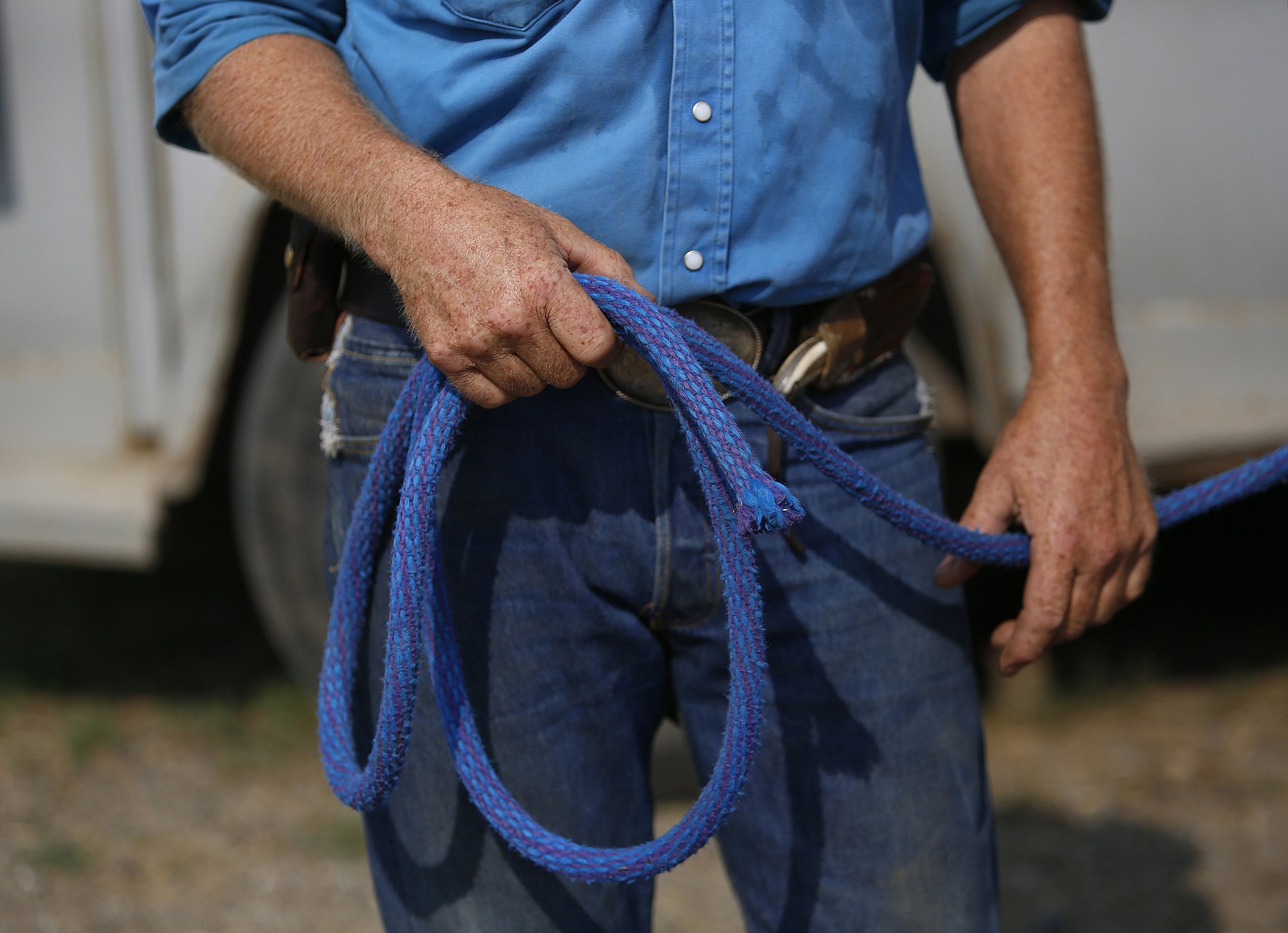TEANAWAY VALLEY — Bill Johnson’s border collie, Nip, was just doing her job when the black cow wheeled and lunged at the dog.
Before wolves returned to this valley, that kind of behavior was rare, said Johnson, who — with Nip’s assistance — was driving a group of cattle up a dusty canyon. Now, cows aggressively confront any canine that gets close to their calves.
“It’s a sign that the wolves have been probing the cattle,” he said.
As part of a project called Range Riders, it’s Johnson’s job to keep cows and wolves away from one another. Every day before saddling his horse and heading into the field, he logs onto the computer to see exactly where the valley’s resident wolf pack has been hanging out.
On this scorching summer day, radio collar signals placed them very near the spot where the cow spooked.
“They were right here at 7 a.m.,” Johnson said, reining in his mount along a small creek. Close examination of the muddy banks revealed a few smeared paw prints. Nearby were piles of scat. Johnson dismounted, poked at the poop with an antler handle knife and declared that the wolves had dined on elk, rodents and robins’ eggs.
Johnson became a range rider shortly after wolves returned to the Teanaway area four years ago. With funding from Conservation Northwest and the Washington Department of Fish and Wildlife, the project helps ranchers hire seasoned cowhands to watch over their herds and keep tabs on wolves in the hope of reducing conflicts with the new predators in the neighborhood.
“Wolves bring up so many emotions on all sides,” said Jay Kehne of Conservation Northwest. “We wanted to find that middle ground and work with ranchers to give them the best possible tools for nonlethal deterrence.”
Seven ranch families around the state signed up this year to receive up to $9,000 each — money the conservation group raises from donors. Under a separate program, WDFW signed agreements with 41 ranchers to provide up to $300,000 in statewide subsidies for range riders and other measures — like automated lights and sirens, guard dogs and special flagging for pens — to discourage wolves from attacking livestock.
Rancher Sam Kayser, who owns the 500 head of cattle in Johnson’s care, was among the first to sign up for both programs. Riding with Johnson in mid-July, Kayser said he hadn’t lost a single animal to wolves.
“The wolves are here, and there’s nothing we can do about it,” he said. “I want to believe there’s room for all of us.”
Kayser still holds to that philosophy even though, just days later, circling vultures led Johnson to the carcass of a yearling steer. Wildlife officials confirmed the animal had been killed by wolves.
“I don’t feel it’s a failure,” Kayser said. “It doesn’t mean I like it, but it’s just one loss in four or five years.”
And under his agreement with the state, Kayser can expect timely compensation for the dead steer. “I appreciate that, and that’s the way it should be,” he said. “I shouldn’t have to carry the financial burden for the public getting to have wolves.”
After the comeback
As in most of the United States, wolves were hunted to near-extinction in Washington decades ago. The animals began making a comeback in the state in the early 2000s. Today, Washington is home to at least 68 wolves in 16 known packs.
With four or five animals, the Teanaway pack is the closest to the state’s urban corridor. The majority of the wolves are concentrated in northeast Washington, where conflicts have been more severe. Wolves killed three cows and a calf north of Chewelah, Stevens County, last month. Last year, a sheep rancher in Stevens County documented 26 wolf-kills and lost an additional 200 animals without a trace.
The state sent in a marksman to target problem animals in that pack, but he accidentally killed the alpha female.
Shooting wolves is — and should be — a last resort, Kehne said.
Johnson’s duties as a range rider aren’t that different from those of any cowboy. Much of his time is spent moving cattle from one place to another — sometimes to avoid wolves, but more often to optimize grazing. Just having a human around the cows may be the best wolf-deterrent of all, he explained.
In some ways, the programs are throwbacks to the past, when cowboys stuck with their herds. But after predator populations plummeted, many ranchers cut back on staff to save money.
“Range riders are an old concept, but they’re relatively new again for the new generation of producers,” McCanna said.
‘Sooner or later’
Researchers from WSU are conducting a multiyear study on the effectiveness of range riders and other nonlethal deterrents. A better understanding of what works will be key as wolves move into new territory across Washington, Kehne said.
“Sooner or later, they’re going to show up outside that 3-acre alpaca ranch on the west side of the Cascades,” he said.
Hostility to wolves remains high east of the mountains, and Kayser said he’s sympathetic to ranchers who are facing much higher wolf numbers than in the Teanaway.
Several fellow ranchers accuse him of selling out.
“Some of them say, if you sign that agreement you’re saying it’s OK for wolves to kill your cattle,” Kayser said. “I call B.S. on that. To me, the goal is coexistence.”
Still, he was relieved when the tracking data showed that soon after killing his calf, the Teanaway pack moved off and is now ranging through more distant canyons.
“The wolves are here, and there’s nothing we can do about it. I want to believe there’s room for all of us.”



